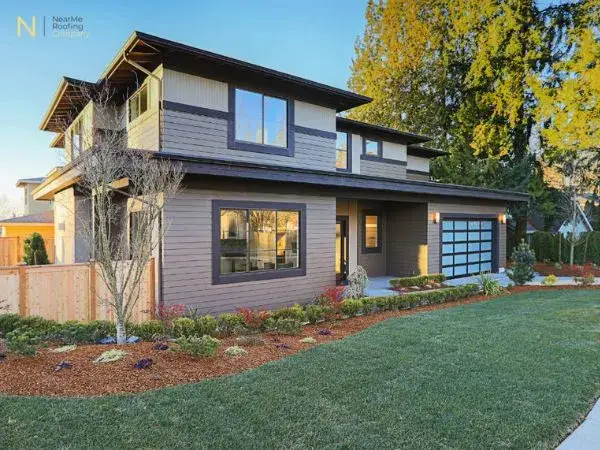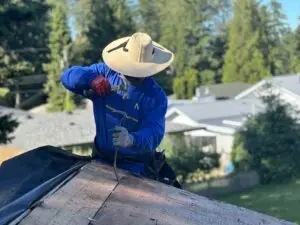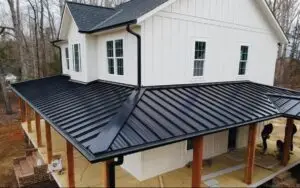Why the Minimum Metal Roof Pitch Matters for Your Home
Some homes with metal roofs handle heavy rain and snow effortlessly, while others struggle with leaks and drainage problems. What makes the difference? The answer lies in a significant factor: the minimum metal roof pitch.
Preventable problems plague many homeowners who don’t grasp the importance of proper roof pitch. The right pitch for your metal roof extends beyond meeting building codes. Your home’s long-term protection and roofing investment depend on it.
This piece explains everything about metal roof pitch requirements, from simple measurements to climate-specific recommendations. You’ll discover the perfect pitch for your home and understand why this choice shapes your roof’s performance more than you might expect.
Understanding Metal Roof Pitch Basics
The simple understanding of metal roof pitch stands as a vital element that NearMe Roofing sees as fundamental to every successful roofing project.
What is roof pitch and why it matters
Roof pitch measures your roof’s steepness as a ratio of vertical rise to horizontal run. A roof’s pitch shows how many inches it rises for every 12 inches of horizontal distance. A 4:12 pitch means the roof goes up 4 inches across every 12 inches of horizontal space.
How pitch affects your home’s appearance
Your metal roof’s pitch significantly impacts your home’s curb appeal. Steeper pitches add elegance and grandeur that complement traditional architectural styles. Low-pitched roofs create a sleek, modern look that works well with contemporary home designs.
Common metal roof pitch measurements
Our metal roofing installations frequently use these standard pitches:
- Low slope: 2:12 to 3:12 pitch – ideal for commercial buildings
- Moderate slope: 4:12 to 8:12 pitch – most common for residential homes
- Steep slope: Above 8:12 pitch – perfect for areas with heavy snowfall
Building codes state that the minimum slope for standard metal roofs without lap sealant must be three units vertical in 12 units horizontal. Metal roofs with lap sealant can work with a minimum of one-half unit vertical in 12 units horizontal.
Selecting the right pitch protects your investment. A well-pitched metal roof will give effective water drainage and stop problems like ponding that lead to early deterioration.
How Roof Pitch Impacts Your Home’s Protection
NearMe Roofing Company understands how using the right metal roof pitch can protect your home. Let’s look at three vital ways pitch affects your home’s safety.
Water drainage and leak prevention
Water management depends on getting the pitch right. A steeper pitch lets water flow off faster and stops it from pooling or seeping through. Metal roofs without lap sealant need a minimum pitch of 3:12 to prevent water damage. Our team’s experience shows that even small pitch adjustments can change how water moves across your roof’s surface.
Snow load management
Your roof’s pitch is vital for protection against snow. Our team recommends steeper pitches in snowy regions because they:
- Help snow and ice slide off faster
- Spread snow weight better
- Lower structural stress risks
Building codes in snow-heavy areas require specific minimum pitches. Our experience shows that 6:12 or higher pitches work best where snow falls often.
Ventilation considerations
Your metal roof needs good airflow, and pitch plays a key role. Steeper pitches create better natural ventilation by maximizing the space between eaves and ridge. This improved airflow helps you:
- Keep attic temperatures stable
- Cut down moisture
- Stop condensation problems
These three protection aspects help your metal roof defend against the weather while staying strong and stable.
Choosing the Right Metal Roof Pitch for Your Climate
Climate also determines the right metal roof pitch for your home. Our expertise shows that solutions working well in sunny Florida might not suit snowy Minnesota.
Regional weather considerations
Steeper pitches work best in regions with heavy precipitation to ensure water and snow runoff quickly. A pitch between 4:12 and 7:12 provides the best protection in areas with heavy snowfall. Our field experience shows that snow-prone areas face issues with pitches over 6:12 due to massive snow slides. Pitches under 1:12 create problems too.
Building code compliance
Local building requirements guide our installations. The International Residential Code specifies these minimum slopes for metal roofs:
- Standing seam systems: minimum 1/4:12 pitch
- Lapped, non-soldered seam with sealant: minimum 1/2:12 pitch
- Lapped, non-soldered seam without sealant: minimum 3:12 pitch
Climate-specific pitch recommendations
Our extensive experience with weather conditions leads us to recommend:
- High Snowfall Areas: 6:12 pitch for optimal snow shedding
- Hurricane-Prone Regions: Steeper pitches to offset high winds
- Coastal Areas: Salt exposure needs engineered aluminum systems
Regions with intense rainfall or strong winds benefit from steeper pitches that prevent water intrusion and reduce wind uplift pressure. Areas experiencing frequent storms need pitches that go beyond minimum requirements to provide extra protection.
Benefits of Proper Metal Roof Pitch
As a trusted roofing company in Seattle, we’ve installed hundreds of metal roofs and the benefits of using the right metal roof pitch cannot be understated. Here’s why the minimum metal roof pitch matters for your home:
Increased durability and longevity
Metal roofs with the right pitch can last 50-70 years with minimal upkeep. A properly pitched metal roof needs almost no maintenance except quick checks around vent pipes and other openings. The roof’s design helps water flow away smoothly and prevents early wear that often affects poorly pitched roofs.
Energy efficiency advantages
Your metal roof’s pitch can affect your energy bills by a lot. Our customers see these benefits:
- Up to 30% reduction in monthly cooling costs
- 10-25% decrease in cooling expenses through better heat reflection
- Better temperature control with proper ventilation and insulation
Metal roofs at the optimal pitch reflect UV rays better and help maintain comfortable temperatures in your home throughout the year. This combination of reflectivity and proper pitch creates an energy-saving system that delivers results for decades.
Effect on home value
A properly pitched metal roof can boost your home’s resale value by up to 6% compared to traditional roofing materials. This leads to a solid return on investment. To cite an instance, see a $750,000 home where a well-designed metal roof could add $45,000 to the property value. Buyers love knowing they won’t need a roof replacement during their ownership.
Conclusion
Metal roof pitch is a vital factor that shapes your home’s protection, efficiency, and value. Proper pitch selection protects against water damage, manages snow loads, and creates optimal ventilation for your home.
Your home deserves the right metal roof pitch. NearMe Roofing Company provides expert guidance on metal roofing solutions that match your specific needs. Note that the right pitch for your metal roof goes beyond meeting minimum requirements. The right choice maximizes your investment and ensures long-term protection. A properly selected pitch transforms your metal roof into a reliable shield against harsh climate conditions.
FAQs
What is the minimum recommended pitch for a metal roof?
The minimum recommended pitch for a metal roof depends on the type of system. For standing seam metal roofs, the minimum pitch is typically 1/4:12 (1/4 inch rise per 12 inches of horizontal run). However, for lapped, non-soldered seam systems without sealant, a minimum of 3:12 pitch is recommended.
Can a metal roof be installed on a low-slope surface?
Yes, metal roofs can be installed on low-slope surfaces, but the appropriate panel profile must be used. While most metal roofing panels work well with a 3:12 pitch or greater, special considerations are needed for pitches as low as 1:12 or 2:12 to ensure proper water drainage and prevent leaks.
How does roof pitch affect snow management on metal roofs?
Roof pitch can significantly how snow affects your metal roofs. A pitch between 4:12 and 7:12 is generally optimal for areas with heavy snowfall. Steeper pitches above 6:12 can cause sudden, large snow slides, while pitches below 1:12 are problematic in snow-prone regions, potentially leading to excessive snow accumulation.
What are the benefits of choosing the right pitch for a metal roof?
Selecting the appropriate pitch for a metal roof extends the durability of your metal roof, improves energy efficiency with up to 30% reduction in cooling costs, and increases home value by up to 6%. The right pitch also ensures better water drainage, snow shedding, and ventilation.
How does climate influence the choice of metal roof pitch?
Climate plays a crucial role in determining the optimal metal roof pitch. In regions that experience heavy precipitation or snowfall, steeper pitches are typically recommended for efficient water and snow runoff. Hurricane-prone areas benefit from steeper pitches to offset high winds, while coastal regions may require special considerations for salt exposure. Reach out to us today for recommendations in the Pacific Northwest region.





